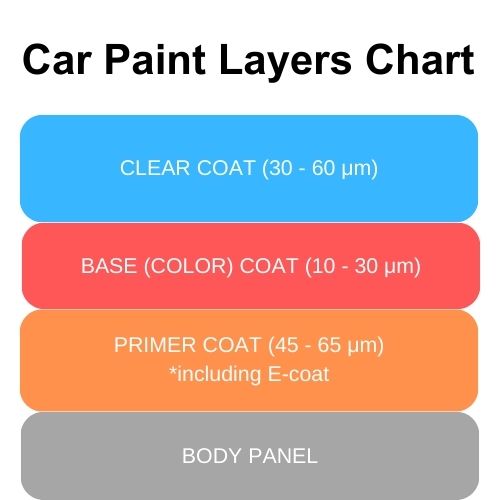How To Measure Car Paint Depth Using a Paint Thickness Gauge
Car Detailing Planet is a part of Amazon Associates. As an Amazon Associate, we earn from qualifying purchases. Read our Affiliate Disclosure to learn more.
Measuring car paint thickness is a very important step when you’re polishing cars. Here’s how to use a paint thickness gauge to measure the car paint depth.
Key Takeaways:
- Turn on the paint thickness gauge.
- Choose a measurement unit, preferably microns, for precision.
- Ensure calibration with provided samples.
- Position the sensor on the car surface and wait for the display results.
- Measure multiple times on each panel for average depth.
How To Use Paint Thickness Gauge To Measure Car Paint Depth

Measuring car paint thickness is effortless, thanks to excellent coating thickness gauges.
Steps For Measuring The Car Paint Thickness:
- Turn on the paint thickness gauge.
- Pick a unit – I prefer microns (μm) since they are more precise when compared to mills.
- Make sure it’s calibrated – when you buy the gauge, you’ll probably get some samples inside the box to check if the sensors are calibrated. It’s a piece or two of metals with some plastics of various thicknesses.
- Lean the sensor to the car surface you want to measure and wait for results to be shown.
- Measure each panel a few times – make sure to make a few readings on every panel. Each measurement should be done on a different spot. That way, you can get some average paint depth.
Those are the most important steps you should take when measuring the car coating thickness.
If you’re going to polish or compound the car, make sure that you get good enough results. That way, you’ll make sure that the clear coat is thick enough for safe polishing.
How Do Paint Thickness Gauges Work
Digital paint thickness gauges work by measuring the distance between the body panel and the sensor on the device. The distance measured is the overall thickness of the paint (primer coat, base coat, and clear coat).

Most paint thickness gauges can work on metal and aluminum car panels only. However, some more expensive and professional devices can measure the paint thickness, even on plastic and carbon panels.
Also, some highly professional paint depth gauges may tell you the exact thickness of each coating (primer, base, and clear coat). But they’re still too expensive for most people out there. There’s just no ROI to use them.
What Data Do Paint Depth Gauges Show
Most paint thickness gauges show one data only, but it can be shown in two different units:
- Microns (μm) – it’s 1/1000 of a millimeter. In my opinion, it’s the unit you should measure car paint thickness since it’s much more precise than the mills.
- Mills – it’s 25.4 microns or 1/1000 of an inch. As you can see, microns are much more precise. (make sure not to think it’s a millimeter).
Also, some devices will show you the result without decimals, and some of them will show you even two decimals. I suggest you always buy a gauge that shows decimal numbers, especially if you want to measure the paint depth in mills.
Today, most coating thickness gauges can save results and count the average measures, which can be exported to the computer or directly read from the device.
Honestly, the more features they have, the better. There are gauges with wifi or Bluetooth options so that you can read the data on your phone, gauges with external sensors, etc.
If you don’t have a coating thickness gauge but want to buy one, check out my article: Best Paint Thickness Gauges
What Are Good Paint Depth Results
There’s no definitive answer to how thick paint should be on any vehicle. Each vehicle is different, even from the same manufacturers. However, there are some general rules you should follow.
The average paint depth of cars is around 100-150 microns or about 4-6 mills, depending on what unit you use to measure the thickness.
| Manufacturers | Average Paint Thickness |
|---|---|
| European Cars | 100 to 150 microns (μm) / 4 to 6 mills |
| USA Cars | 100 to 150 microns (μm) / 4 to 6 mills |
| Japanese Cars | 90 to 120 microns (μm) / 3.5 to 4,7 mills |
As you can see, not all cars use the same paint depth standard. Also, you can expect more expensive cars to have thicker paint, while cheaper cars will often have thinner paint.
A good paint depth reading is anything that’s above 90 microns (3.14 mills). With that result, you’re probably safe to do a paint correction. Again, it depends on the type of the vehicle and its factory paint depth.
The best way to tell if there’s still enough clear coat is to measure the average, and then you’ll know what a good result of a specific part is.
Related: 5 Common Questions About Clear Coat
For instance, if the average thickness is 120 microns (µm), and the hood is 80 microns, there’s probably not much clear coat left there, and you should be extremely careful if you polish that car. Usually, the clear coat thickness varies between 40-50 microns (µm).
When To Use Paint Thickness Gauges: 3 Situations

Here, I’ll show you the three most common reasons why people use paint thickness gauges.
1. Before Polishing and Compounding
Before you do a paint correction process, you should always check the paint depth and estimate the clear coat thickness. Of course, you can never tell 100% how thick is a clear coat, but paint gauges can help a lot with estimating that.
2. To Check Your Painting Job
When you’re painting a vehicle, it’s good to check the paint depth after you finish painting all the coats (primer, base, and clear). That way, you’ll know if you did a good or a bad job. It’s always best to get readings similar to the factory ones.
When you do it a few times on a few different panels, you’ll get a better feeling when painting the car, and you’ll know how many coats of paint or clear coat you should apply next time.
If you’re a beginner, it’s a great way to learn about painting vehicles. You just spray some old spare parts and then check the results with the coating thickness gauge.
I have found a fantastic course for beginners to learn how to spray paint any car. It’s called Learn Auto Body and Paint (check it now).
3. When Buying a Used Car
When you’re buying a used car, and you’re not sure if the car was re-painted or had some accidents, using paint thickness gauges can help you with that.
One of the signs that the car was re-painted or had fillers is if there is a significant deviation in the paint thickness of different car panels.
If you get incredibly high readings (250+ microns), it’s a sign that there are fillers beneath the paint, and that car probably had some crush, or the metals were rusty. If you get those readings, I advise you to check the VIN history of the vehicle.
Frequently Asked Questions
Luckily, with the expansion of the paint thickness gauges market, the prices went down. As always, there are more expensive and cheaper products. You can find a good gauge for around $100. The prices can go up to $1000 if you want professional tools. Check my recommended coating thickness gauges here.
Yes. You’ll need it sooner or later, especially if you’re polishing vehicles. It’s a great piece of equipment that can help you a lot.
They’ll work, but I wouldn’t trust some device that costs $30. It’s just not enough money to get a reliable device.
With most middle-priced gauges, that won’t be possible. However, if you want to invest in a more professional device, you’ll be able to measure the thickness of plastic and carbon panels.
If you want to check the exact thickness of specific car paint coats (e.g., clear coats), you’ll have to use expensive devices that have that option. Most paint thickness gauges don’t have that option.
